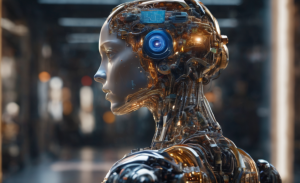Why we need to develop AI to work like the brain
5 min readTable of Contents
Advances in artificial intelligence (AI) bring with them energy-intensive challenges.
A study predicts that as data growth continues, the cumulative energy consumption for binary operations exceed 10^27 joules by 2040 could – more than the world can produce.
So let’s examine the impact of AI on the environment, the limitations of traditional computing models, and how neuromorphic computing (NC) draws inspiration from the energy-efficient human brain, leading to sustainable AI advances.
AI: The Dilemma
In recent years, artificial intelligence (AI) has reached remarkable milestones. Examples include the development of language models such as ChatGPT and advances in computer vision that enable autonomous technologies and improve medical imaging.
AI’s amazing reinforcement learning capabilities, as demonstrated by its victories over human masters in games such as Chess and Go, also highlight its remarkable capabilities.
While these developments have enabled AI to transform industries, promote innovation in the economy, achieve scientific breakthroughs and have a lasting impact on society, they are not without consequences.
Aside from this alarming prediction for 2040, storing large amounts of data and training AI models on these datasets already requires significant energy and computing resources, as research shows:
Therefore, as AI advances, it is crucial to strike a balance between advances and energy needs while taking environmental impacts into account.
Von Neumann Architecture: The Bottleneck
AI models work within the framework of the Von Neumann architecture, a computer design that essentially separates processing and storage and requires constant communication between the two.
As AI models become more complex and data sets become larger, this architecture faces significant obstacles.
First, the processing and storage units shared a communication bus, which slows down AI calculations and affects training speed.
Second, the processing unit of the architecture lacks parallel processing capabilities, which affects training.
While GPUs mitigate the problem by allowing parallel processing, they introduce data transfer overhead.
The frequent data movement creates additional overhead due to the memory hierarchy, which impacts performance.
Large data sets cause long memory access times and limited memory bandwidth, leading to performance bottlenecks.
Complex AI models put a strain on Von Neumann systems and limit storage and processing capacities. These limitations have led to high energy requirements and carbon dioxide emissions in AI systems.
Addressing these challenges is critical to optimizing AI performance and minimizing environmental impact.
Biological Brain: The Inspiration
The human brain is more powerful than any AI machine in terms of cognitive abilities.
Despite its immense power, the brain is incredibly light, consuming just 10 watts, unlike the energy-hungry machines we use today.
It is estimated that even with this modest energy budget, the brain can achieve an astonishing amount of power 1 exaflop can achieve 1000 petaflops corresponds – a performance that the fastest supercomputer in the world with its 30 megawatts of power at 200 petaflops can hardly achieve.
The secret of the brain lies in its neurons, which, unlike the Von Neumann architecture, integrate processing and memory.
The brain processes information in a massively parallel manner, with billions of neurons and trillions of synapses working simultaneously. Despite its remarkable complexity, the brain remains compact and economical in its energy consumption.
What is neuromorphic computing?
Neuromorphic computing (NC) is a branch of computer technology inspired by the structure and functioning of the human brain’s neural networks.
The goal is to design and develop computer architectures and systems that mimic the parallel and distributed processing capabilities of the brain and enable efficient and energy-efficient processing of complex tasks.
This approach aims to overcome the limitations of the Von Neumann architecture for AI tasks, particularly by consolidating storage and processing into a single location.
To understand NC, it is important to know how the brain works. Neurons, the building blocks of the brain, communicate via electrical signals to process information.
When they receive signals from interconnected neurons, they process them and send out impulses.
These impulses travel along pathways formed by neurons, with synapses – gaps between neurons – facilitating transmission.
NC uses analog memristors to replicate the function of synapses and achieve memory by adjusting resistance.
Fast communication between neurons is typically achieved through the use of spiking neural networks (SNNs).
These SNNs connect spiking neurons to artificial synaptic devices such as memristors, which use analog circuits to mimic brain-like electrical signals.
These analog circuits offer significantly higher energy efficiency compared to traditional Von Neumann architecture.
Neuromorphic technologies
The rise of artificial intelligence is increasing the demand for neuromorphic computing.
It is expected that the global market for neuromorphic computing from USD 31.2 million in 2021 to around USD 8,275.9 million by 2030, with an impressive CAGR of 85.73%. In response, companies are developing neuromorphic technologies, such as: E.g.:
- IBM’s TrueNorth: The CMOS neuromorphic integrated circuit, introduced in 2014, has 4096 cores, over a million neurons and 268 million synapses. TrueNorth overcomes von Neumann bottlenecks and only consumes 70 milliwatts.
- Intel’s Loihi: Introduced in 2017, Loihi is 1,000 times more energy efficient than typical neural network training. It has 131,072 simulated neurons and has a 30 to 1000 times more energy efficient than CPUs/GPUs.
- Akida NSoC from BrainChip: With its spiking neural network architecture, it integrates 1.2 million neurons and 10 billion synapses. Akida supports low-power, real-time AI applications such as video object detection and speech recognition.
These innovations are a sign of the rapid development of neuromorphic computing to meet AI needs.
Challenges of Neuromorphic Computing
To realize the potential of NC in AI, certain challenges must be overcome.
First, developing efficient algorithms compatible with neuromorphic hardware is crucial. This requires a deep understanding of hardware operations and tailor-made adjustments.
Second, the need to process larger, complex data sets is critical. Current NC experiments involve relatively modest data sets, so the performance of the system on larger and more complex problems needs to be investigated.
The larger and more complex the data sets are, the higher the demands are on the NC system. The challenge is to develop NC systems that meet these requirements while delivering precise and effective solutions.
Despite encouraging results from smaller tests, NC’s performance on larger and more complicated data sets is not yet proven.
Further research and development is essential to optimize the technology for practical applications.
The bottom line
Neuromorphic computing (NC) draws inspiration from the brain’s neural networks to revolutionize AI with energy efficiency.
As advances in AI lead to environmental problems, NC offers an alternative by mimicking the brain’s parallel processing.
Unlike Von Neumann architecture, which compromises efficiency, NC shares memory and processing to overcome bottlenecks.
Innovations such as IBM’s TrueNorth, Intel’s Loihi and BrainChip’s Akida NSoC show the potential of neuromorphic technologies.
However, there are other challenges, including adapting the algorithms and scalability to larger data sets. The further development of NC promises energy-efficient AI solutions with sustainable growth potential.
Crypto exchanges with the lowest fees 2023






